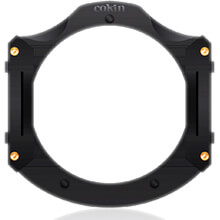
Filter Tips: Neutral Density Filters and Landscape Photography
By Ian Mayou | Professional Photographer, www.ianmayouphotography.com
One of the topics that I always cover on my landscape photography workshops is the use of filters. After we've been through the how, when and why to use them, the first question that usually follows is which filter should I buy?
There is a dizzying array of filters on the market and with different manufacturers using different terminology, it's hardly surprising that those new to the subject find themselves in need of a bit of guidance.
Let's start with the easy part. If you have paid to come on a workshop you probably have more than a passing interest in landscape photography, so I always recommend getting the best you can afford. I have been using Cokin since I first started landscape photography and although there is a lot more choice now than there was then, the simple Cokin system has stood up to the years of abuse I've put it through, and the filters consistently deliver the excellent image quality I need.
Where things can get complicated is in the choice of filters, particularly with graduated neutral density filters (which is a bit of a mouthful, so let's call them grads for short). For those who aren't familiar with them, grads are filters which are half clear and half tinted with a neutral tint. In situations when the sky is a lot brighter than the foreground (sunrise, or sunset for example) that difference in brightness is often greater than the camera can deal with. A grad filter can be positioned in front of the lens so that the dark half covers the sky with the clear part over the foreground, balancing the difference between the two levels so that the camera's limited dynamic range can cope.
That all seems fairly simple, so what's the problem? Well, 'which graduated filter should I buy’ is not a particularly easy question to answer, as the choice is very much dependent on what you will be photographing and how much you want to spend.
Like most filters, ND graduated filters come in various strength of tint, but they also come in different graduations, usually soft or hard. Soft is a gentle graduation between the tinted and clear areas while hard is a more sudden change. The problem has always been that there is no 'one-size-fits-all' graduated filter.
Hard grads are suited to scenes where the horizon is clearly defined - coastlines for example, where it's easy to position the filter along the horizon - while soft grads are ideal for situations like mountainous landscapes, where there is no clear horizon and the soft graduation blends seamlessly into the mountains. If you use soft grads for coastal photography, the soft transition won't be strong enough to cope with bright areas near the horizon. Conversely, using hard grads for a mountain scene will leave an unnatural dark line across the mountains. So, when somebody asks which filter is the best to start with, or something along those lines, I go into a long and winding explanation of the strengths and weaknesses of each.
Until that is, the introduction of the Cokin filters medium grad, which as you've probably gathered is where this particularly long and winding introduction was leading. The graduation of the medium grad, as you'd expect, is somewhere between hard and soft. Soft enough to avoid the dark lines associated with hard grads while still being hard enough to hold back bright areas near the horizon, the medium grad is perfect for those difficult situations where the horizon is visible but with something like a tree or building breaking it. They are also far easier to position than hard grads, which need to be lined up carefully with the horizon to avoid leaving a tell-tale sliver of bright sky.

I spend a lot of time at the coast, so I've always used hard grads for the most part and on the odd occasion that I need them (it's not too hilly round where I live) I use my soft grads, but since its introduction, the medium grad has become my favourite bit of kit and is the closest thing to a ‘one-size-fits-all’ filter out there.
In landscape photography, there are two ways that you can use an ND filter. First, slow down your shutter speed and second, shoot with a wider aperture in bright environments. Slowing down the shutter speed is the most common method. By placing an ND filter in front of your lens, you will reduce the amount of light that enters your camera, causing moving objects to be blurred.
A popular technique in landscape photography is to shoot with a longer exposure time. This technique involves using a shutter speed of a few seconds – or even several minutes - to create dreamy, blurry effects within water or clouds.
Waterfalls, rivers and seascapes are exactly the types of places where neutral density filters come into play and how photographers are able to achieve such beautiful photos by transforming otherwise common points of interest into breathtaking works of art.
My go-to ND filters for waterfalls and seascapes are my Cokin Z-Pro (L) Nuances Extreme ND1024 10-Stop and ND 64 6 Stop Filter, which cover most lighting conditions and the effects I’m trying to achieve. They also produce no colour cast, unlike other brands, which makes post processing a lot easier.
I also carry other ND strengths as and when I need them, in case the 10 stop and 6 stop aren’t quite right for the conditions I’m shooting in.
The Nuances Extreme filters are made from a new type of tempered optical glass that is 4 times stronger than the previous series. This means they are built to withstand extreme conditions and those inevitable drops, nicks, and scratches. A new coating process ensures uniform density, which results in stunning neutrality and absolute colour consistency. Switching from one density or style to another will still yield the exact same colour results, with no adjustments necessary.
For more information please contact our Sales Desk:
+44 (0)1457 851000 | sales@holdan.co.uk.
11 Apr 2024
YoloLiv Instream Installed at the TikTok Korea Headquarters
03 Apr 2024
Atomos In the Clouds: Redefining Video Production Efficiency
27 Mar 2024
NDI and IP-enabled workflows from Panasonic
27 Mar 2024
Mastering Post-Production: DaVinci Resolve’s AI Innovations for Content Creators
-Nuances-Extreme-ND1024.jpg)
-Nuances-Extreme-ND64.jpg)
-Nuances-Extreme-Grad-ND8.jpg)
-Nuances-Extreme-Grad-ND16.jpg)
-Nuances-Extreme-Grad-ND4.jpg)

.jpg)
.jpg)




